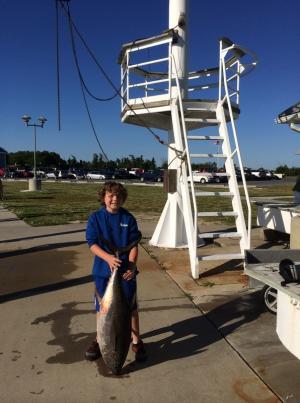Offshore fishing is hot
Offshore fishing usually gets hot in August and September, but this year it began in early June and is still going strong. The even better news for Delaware anglers is the action has been in the Poor Man’s and Baltimore canyons. Later it will move south to the Washington, and that is a much longer run for Delaware boats.
No doubt a charter boat will be the way to go for most anglers, but if you have a boat that can handle the 120-mile round trip without running out of fuel, it is possible to make this a do-it-yourself project. I have fished offshore in a 20-foot Bertram and a 70-foot Spencer, and while the Spencer definitely had more creature comforts, the Bertram got the job done.
I do prefer deep V boats for offshore fishing because they can handle big seas much better than any other hull. They do use more fuel and are a tad bit bouncy when drifting or at anchor, but that is because they are not designed to drift or anchor. As for fuel, my 24 Albemarle held 120 gallons and I used between 80 and 90 gallons when running offshore. The Bertram held 30 gallons, and I needed another 15 gallons in plastic jugs to make it out to the 30 line and back. I do not recommend this method, as filling a gas tank at sea is fraught with danger.
Most of my early trips to the canyons were made in a 22-foot Mako owned by my brother-in-law Paul Coffin. The boat had two 75-hp Johnson motors and an extra fuel tank installed where the cooler should have been. It did not have a deep V hull, and I blame my current bad knees on too many hours bouncing around in that boat.
You don’t need a full complement of Penn International reels to fish offshore. I have been using Penn Senators since 1973, and they have done the job very well. I would suggest four 4/0 Senators spooled with 30-pound mono. These reels can be fished standing up, since most small boats do not have fighting chairs. This outfit can handle any yellowfin or white marlin you are likely to hook. Bigeyes and blue marlin can be caught on this tackle if you are young and have a lot of time. I can promise you if you purchase a big rod and reel and put it out with the four smaller outfits, the largest fish will always take the smallest bait. That is another one of Murphy’s Laws.
The easiest way to catch fish offshore is with lures. No drop back, just on or gone. There are so many lures to choose from that the only recommendation I have is to choose the smaller ones. I have had success with Mold Craft and Ilander lures. The Mold Crafts are fished naked while the Ilanders usually have a ballyhoo added behind the lure. Make sure you use slow-speed lures unless you want to troll at 8 to 10 knots burning up lots of fuel.
Rigging baits can be a chore. It must be done the night before the trip because trying to do this job on a small boat in four- to six-foot waves requires more experience than most people possess. It is possible to buy baits already rigged, but this can be very expensive.
The weather is the determining factor in every fishing excursion, and this is especially true when running 60 miles offshore. Any wind greater than 15 knots and seas higher than three feet should be the end of any offshore trip. Even when you have flat, calm conditions in the morning, you can expect some sloppy seas during the ride home in the afternoon. That lovely sea breeze that keeps all those beachgoers cool will make the seas from the 20-Fathom Line back to the beach a challenge.
The one item you must have before running offshore is an EPIRB (emergency position-indicating radio beacon). These are a bit pricey, but will save your life when trouble comes calling.
Fishing report
Croaker still rule the bay with plenty of fish caught out of Lewes and Bowers Beach. A few kings, flounder and the occasional black drum will take a croaker bait.
It seems like we are seeing a few more flounder from the bay to the ocean and in Indian River Inlet and Bay. More flounder are showing up on the reef sites in the bay as the warmer water in the rivers and shallow areas along the beach has them looking for deeper, cooler water. While limits are still rare, the flounder being caught are bigger than in past years with fish to eight pounds taken on a somewhat regular basis.























































